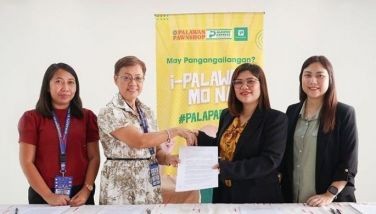Prove ‘countryside partner’ tag, Reyes challenges rural bankers
October 21, 2003 | 12:00am
The Bangko Sentral ng Pilipinas (BSP) challenged the rural banking system to make good claims that they are the "ideal partners for countryside development."
In fact, BSP Deputy Govenor Alberto V. Reyes zeroed in on microfinance as the critical area wherein the rural banks (RBs) could make good their claims.
Speaking before rural bankers last week, Reyes said the challenge is based on the reality that there still remains a "huge and unmet demand" for microfinance services in the countryside.
"Futhermore, there is definitely much to be done insofar as reaching a larger number of disadvantaged Filipinos and uplifting the quality of their lives," the deputy governor said.
Based on data collected by the BSP, 40 percent of country’s population of almost 80 million is classified as existing below the poverty line. From among the 40 percent, 4.1 million are reportedly engaged in some kind of entrepreneurial activity.
However, most of these micro-entrepreneurs fall victims to loan sharks, usurious traders and the notorious five-six lenders. It has been oftentimes said that there was no limit to the ability of the Filipino to start some kind of legitimate business. The problem was access to honest credit as the BSP states that only one million of the 4.1 million avail of decent credit.
"The micro-entrepreneurs who can not access formal financial institutions have to resort to informal lenders to augment the necessary capital needed to increase their business activities," Reyes pointed out.
But engaging in microfinancing is not child’s play but a serious financial and management practice. That prompted the deputy governor to caution the country’s more than 700 RBs nationwide.
Since the practice of microfinance deviates from the standard or "traditional" banking practices, it pays to first learn the basics and deal with those with first-hand experience.
Aside from the BSP, there are several private sector groups that have dealt in the practice including non-government organizations (NGOs), a handful of RBs, and the Microenterprise Access to Banking Services (MABS), a program that provides technical assistance and training to rural banks in microfinance. It is financed by the United States Agency for International Development (USAID).
Reyes said that aside from knowing the orientation, the technical, and organizational implications of entering the practice of microfinance, the RB "must commit to adequately prepare itself to engage in such a business."
The means deciding on what microfinance methodology is applicable in their locality, and suited for the "organization‚s structure, goals and objectives."
It is also important to have an efficient loan tracking system and information system since the very character of microfinance is a huge number of accounts with small amounts, with numerous almost daily transactions.
He added that the RBs that decide to engage in microfinance must regularly enhance its operations and maintain a level of sustainability and viability by subscribing to a set of performance standards and best practices.
In a separate interview, former Philippine Air Force general turned rural banker William K. Hotchkiss III claims that adapting performance standards and best practices while engaging in microfinance has actually improved the overall performance of his rural bank.
The Cantilan Bank (also known as the Rural Bank of Cantilan) in Surigao del Sur more than doubled its deposits and loan portfolio after adopting banking practices through the MABS program.
"We started practicing microfinance as an almost completely different banking practice but when we adopted the same methods to our regular banking practices, the bank improved tremendously," Hotchkiss said.
Before it started adopting the new methodology in 1999, its resources stood at P113 million but ballooned to P264 million after only four years. Its past due ratio dropped to 3.99 percent from 9.83 percent.
It has a loan portfolio of P21 million servicing 4,144 micro-entrepreneurs.
In fact, BSP Deputy Govenor Alberto V. Reyes zeroed in on microfinance as the critical area wherein the rural banks (RBs) could make good their claims.
Speaking before rural bankers last week, Reyes said the challenge is based on the reality that there still remains a "huge and unmet demand" for microfinance services in the countryside.
"Futhermore, there is definitely much to be done insofar as reaching a larger number of disadvantaged Filipinos and uplifting the quality of their lives," the deputy governor said.
Based on data collected by the BSP, 40 percent of country’s population of almost 80 million is classified as existing below the poverty line. From among the 40 percent, 4.1 million are reportedly engaged in some kind of entrepreneurial activity.
However, most of these micro-entrepreneurs fall victims to loan sharks, usurious traders and the notorious five-six lenders. It has been oftentimes said that there was no limit to the ability of the Filipino to start some kind of legitimate business. The problem was access to honest credit as the BSP states that only one million of the 4.1 million avail of decent credit.
"The micro-entrepreneurs who can not access formal financial institutions have to resort to informal lenders to augment the necessary capital needed to increase their business activities," Reyes pointed out.
But engaging in microfinancing is not child’s play but a serious financial and management practice. That prompted the deputy governor to caution the country’s more than 700 RBs nationwide.
Since the practice of microfinance deviates from the standard or "traditional" banking practices, it pays to first learn the basics and deal with those with first-hand experience.
Aside from the BSP, there are several private sector groups that have dealt in the practice including non-government organizations (NGOs), a handful of RBs, and the Microenterprise Access to Banking Services (MABS), a program that provides technical assistance and training to rural banks in microfinance. It is financed by the United States Agency for International Development (USAID).
Reyes said that aside from knowing the orientation, the technical, and organizational implications of entering the practice of microfinance, the RB "must commit to adequately prepare itself to engage in such a business."
The means deciding on what microfinance methodology is applicable in their locality, and suited for the "organization‚s structure, goals and objectives."
It is also important to have an efficient loan tracking system and information system since the very character of microfinance is a huge number of accounts with small amounts, with numerous almost daily transactions.
He added that the RBs that decide to engage in microfinance must regularly enhance its operations and maintain a level of sustainability and viability by subscribing to a set of performance standards and best practices.
In a separate interview, former Philippine Air Force general turned rural banker William K. Hotchkiss III claims that adapting performance standards and best practices while engaging in microfinance has actually improved the overall performance of his rural bank.
The Cantilan Bank (also known as the Rural Bank of Cantilan) in Surigao del Sur more than doubled its deposits and loan portfolio after adopting banking practices through the MABS program.
"We started practicing microfinance as an almost completely different banking practice but when we adopted the same methods to our regular banking practices, the bank improved tremendously," Hotchkiss said.
Before it started adopting the new methodology in 1999, its resources stood at P113 million but ballooned to P264 million after only four years. Its past due ratio dropped to 3.99 percent from 9.83 percent.
It has a loan portfolio of P21 million servicing 4,144 micro-entrepreneurs.
BrandSpace Articles
<
>
- Latest
Latest
Latest
September 11, 2024 - 2:00pm
September 11, 2024 - 2:00pm
May 6, 2024 - 10:55am
May 6, 2024 - 10:55am
Recommended





























